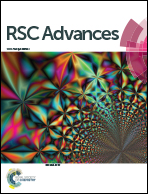Synthesis of novel [3,1]-benzothiazepine and [3,1]-benzoxazepine derivatives with antitumoral activity†
Abstract
A new method for the synthesis of [3,1]-benzothiazepines and [3,1]-benzoxazepines from the reaction of C-allylanilines and isothiocyanates or isocyanates without the need for the isolation of any intermediate is described. The compounds were obtained in good to moderate yields and some exhibited cytotoxic activity against tumor cell lines.
![Graphical abstract: Synthesis of novel [3,1]-benzothiazepine and [3,1]-benzoxazepine derivatives with antitumoral activity](/en/Image/Get?imageInfo.ImageType=GA&imageInfo.ImageIdentifier.ManuscriptID=C3RA44937H&imageInfo.ImageIdentifier.Year=2014)

 Please wait while we load your content...
Please wait while we load your content...